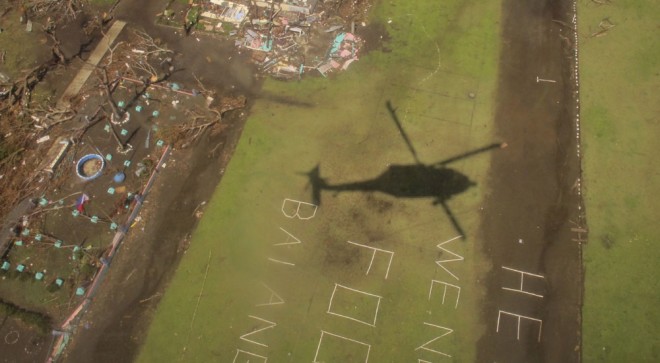‘Help us’: Isolated typhoon victims clamor for food

In this photo taken Saturday, Nov. 16, 2013, the shadow of a US military helicopter on a disaster relief mission is cast passing over a sign pleading for help near Tacloban City. The US military has launched a massive relief effort for victims of Supertyphoon “Yolanda” in an effort to both save lives and build relations with its allies around the region. AP
HOMONHON, Philippines—The message spelt out in giant letters on the ground outside the remote, typhoon-shattered Philippine village was clear enough: “Help Us. We Need Food.”
Easily visible as the US helicopter carrying emergency food supplies made its approach Monday, it reflected the desperation of the villagers 10 days after Supertyphoon “Yolanda” (international name: “Haiyan”) slammed into the central Philippines.
As soon as the chopper touched down and the doors opened, around 100 villagers rushed to the aircraft and began pulling at the bags of rice inside before they could be properly unloaded.
“It’s the first food we’ve had,” a woman shouted as the crew tried to persuade the residents of the tiny inland village in eastern Leyte island to move back.
The rice was finally offloaded and, as the helicopter took off again, one of the villagers gestured wildly with his hands to his mouth, pleading for the crew to return with more supplies.
Article continues after this advertisement“Those in the remote areas are the most desperate,” said Chief Petty Officer Matthew Gensler. “The further out you go, the harder it is.”
Article continues after this advertisementThe helicopter was one of many that have been flying continual sorties off the USS George Washington aircraft carrier since it arrived to spearhead a growing international relief operation.
Yolanda made landfall on Nov. 8, triggering a storm surge that laid waste to large areas of coastline and pummelling inland towns and villages with some of the strongest winds ever recorded.
The official death toll stands at 3,976 with 1,598 people missing. The United Nations estimates up to four million people have been displaced, of whom only 350,000 have found shelter in evacuation centers.
Mood calmer
On the tiny island of Homonhon, which suffered a direct hit from the supertyphoon, the mood was calmer, with villagers waiting patiently as the helicopter crew unloaded water supplies.
The approach to the village offered an aerial view of the destruction inflicted on the island, where thick coconut groves had been torn up and flattened.
Rear Admiral Mark Montgomery, commander of USS George Washington strike group, said that as well as bringing supplies in, its helicopter crews had “airlifted around 5,000 displaced people to safety.”
Although the relief operation took time to get up and running, aid agencies and humanitarian groups have firmly established operational posts in the flattened region’s largest city Tacloban.
The city remains without regular power, but distribution centers have been set up, ensuring a steady flow of food and water to still-traumatiszd residents, while mobile surgical units provide emergency care for the sick and injured.
Some petrol stations have opened and enterprising individuals were selling fuel in Coke bottles Monday by the side of the roads as cars and motorbikes made a tentative return to the streets.
But the overall situation remains critical, and teams were still recovering bloated bodies on Monday from areas in and around Tacloban.
The UN said an estimated 2.5 million people need food assistance, and stressed the importance of ensuring supplies of rice seed for the crucial December-January planting season.
Aquino tours worst-hit areas
President Benigno Aquino, who was criticized over the speed of the initial response to the disaster, toured the worst-hit areas on Sunday and Monday and said he would stay in the region to oversee the relief operation.
Stressing the logistical challenge of accessing so many badly affected people spread out over such an enormous area, Aquino appealed for “patience” and vowed to speed up the distribution where possible.
Although the situation in Tacloban has markedly improved in the past three days, daily life is still a grinding struggle among the ruins of the once thriving coastal city.
An AFP journalist saw one man salvaging wood to rebuild his shack as three bloated bodies—two of them children—lay nearby.
“Please can you tell the authorities to come and pick these up?” he begged.
In Manlurip village just outside Tacloban, Flordeliza Arpon, 32, recounted how she and her eldest child had been separated from her husband and their two other children as the storm waters destroyed their house and almost swept them out to sea.
“We were each sure the others had died, but then we found each other again four days later,” Arpon said.
“We lost everything, but we are still together.”—Amélie Bottelier-Depois